The salty variant of the Hurricane
The Hawker Hurricane was the second main fighter of the RAF in WW2. Since the Spitfire soon became the trusted frontline model, Hawker's model took more diverse roles and of of these became an "expandable" model for CAM-ships, the catapulted "Hurricat". From there, a naval version was developed which entered service in late 1941 with the Fleeir Arm. Only about 800 served with the Royal Navy, compared to more than 14,000 RAF models in 12 versions.Hawker and the Navy
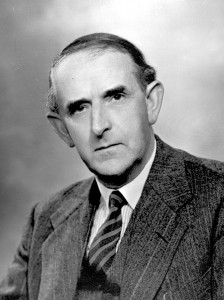 Hawker Aircraft apparead after WWI, following the bankrupcy of Sopwith, test pilot Harry Hawker recuited four other fellow pilots and funded Hawker in 1920. First collaboration with the Navy was the Hawker Hedgehog 1924 prototype, for reconnaissance. Later a derivative of the Horsley also used by the Hellenic Navy, was the floatplane Dantorp, used by the Danish Navy. The latter also purchased the rare fighter Hawker Danecock for its Navy, derived from the Woodcock. The Hawker Harrier was a 1927 prototype of torpeod bomber. The name was resurrected by a far more famous plane in the late 1950s. In 1923, entered young engineer Sydney Camm, which soon rose up the ladder to the top, associating his name to the company for ever.
Hawker Aircraft apparead after WWI, following the bankrupcy of Sopwith, test pilot Harry Hawker recuited four other fellow pilots and funded Hawker in 1920. First collaboration with the Navy was the Hawker Hedgehog 1924 prototype, for reconnaissance. Later a derivative of the Horsley also used by the Hellenic Navy, was the floatplane Dantorp, used by the Danish Navy. The latter also purchased the rare fighter Hawker Danecock for its Navy, derived from the Woodcock. The Hawker Harrier was a 1927 prototype of torpeod bomber. The name was resurrected by a far more famous plane in the late 1950s. In 1923, entered young engineer Sydney Camm, which soon rose up the ladder to the top, associating his name to the company for ever.
Later from 1929 the Hawker Osprey, derived from the Hart, was the first success with the RN (and other navies). A prototype naval fighter was also proposed, the Hawker Hoopoe, in 1928. Closer to the Osprey, the Nimrod (first flight 1931) was a serie of 92 naval fighter for carrier service and another success of the company. It was close to the famous Fury for the RAF, a true legend of interwar aviation. Hawker in the early 1930s cemented its reputation and rapid rise. And then came the Hurricane. All were designed under the direction of Camm.
Development

The very early "Kestrel Monoplane" concept. Although there were restistance to the monoplane in the Air Ministry Major John Buchanan at the Directorate of Technical Development met in August 1933 Sydney Camm, and the latter focused his team on a monoplane version of the Fury, powered by an inline RR Kestrel engine.
Strangely, it's not the air ministry which pushed manufacturers in 1933 to go for monoplanes. Just like at Supermarine with R.J. Mitchell, both men started these studies as private ventures. In fact Mitchell would later soon familiarized first-hand in Germany to the new Me 109 and quite aware of what happened on the continent. In France, the D.500 monoplane fighter family flew already in 1932 and squadrons were now filled with it. The same year, the US introduced the Boeing P26. They were both 1st gen, with open cockpits and fixed undercarriages.
It's only with the rise of International tensions in 1934 that the air ministry changed it's stance and asked for monoplanes, issuing a famous specificatio for it. From there, Camm already had a well advanced paper project, soon to be turned into a mockup. Its very early prototype had a Goshawk engine, but it was swapped for the new and promising Rolls-Royce PV-12. It was also designed to carry four machine-guns, a fixed and spatted undercarriage. By early 1934 the Goshawk was firmly replaced by the PV.12 from Rolls-Royce and the underrcarriage was made retractable.
The structure was built around this new engune. As an inline engine, it allowed streamlining of the nose, but the design was not benefiting from the science of NACA back in the US. There were wind tunnel trials, and flights using small attached ribbons to study the air flaw, but Mitchell and Camm were of the "old school" with for motto "if it's looks right it will fly right"; Empirism and flair ruled as much as mathematics and initial sketches made made with a cray on the floor.
In 1934, so, the British Air Ministry issued at the request of the Royal Air Force, a model able to intercept bombers, the specification F.7/30 asking this model to reach 250 mph, and carry four machine guns. Hawker modified its Fury, as a moniplane, with fixed undercarriage, and with the inline Rolls-Royce Goshawk. But it was rejected by the ministry. In September 1934, he revised it with retractable landing gear, enclosed canopy, and the brand new Rolls-Royce PV-12 engine (later called "Merlin"). The Air Ministry selected it for the second round, assorted by January 1935's F.36/34 specification, based on Hawker's project, but with eight machine guns. It was a clear favorite in this competition in Which Supermarine and Gloster were participating. The latter was the only one sticking with a radial engine.
 Hurricane prototype making its maiden flight in early 1935
Hurricane prototype making its maiden flight in early 1935The Hurricane prototype K5083 first flew on November 6, 1935 (George Bulman at the command). The RAF ordered 600 in June 1936 with operations started by December 1937 in the Fighter Command. 111 Squadron based at Northolt was the first to receive it. Unlike the Spitfire, which followed soon, the philosophy behind the Hurricane was a mix of new and old solutions, making it rugged, reliable and cheap to repair and produce. Not a superb dogfighter like the costly but innovative Supermarine fighter, the Hurricane cemented its legend in WW2 as "the second one (fighter)". Notably during the Campaign of Britain in Augusy-September 1940 it contributed, as the most numerous fighter, to a hard-fought, decisive victory over the Luftwaffe. But later, with limited evolution margins, it was gradually sidelined as a fighter-bomber, excelling in those new duties.
Enters the Sea Hurricane
The need emerged soon of a fighter with good speed and climbing capabilities to defend convoys against Luftwaffe attacks, and in particular later those coming from the FW-200 Condor. It should be recalled that at the time in 1940, the FAA lacked any fighter. There were multirole models like the Fairey Fulmar, or the disastrous Blackburn Roc, or the Gloster Sea Gladiator, of which 98 entered service before 1939, but was more a dogfighter than an interceptor. There were still 53 active when WW2 broke out and the only "monoplan fighter" to replace it was supposed to be the Skua.The way the Hurricane made its way at sea is a strange one. It was not envisioned to have it converted for carrier service at first. They emerged with the desperate idea of the CAM ship. The latter consisted in adapting a catapult to any merchant vessel, with an "expandable" hurricane, tailored to be catapulted. Work was performed by the General Aircraft Limited company, using the now obsolete Hurricane Mk I, with some 80 design modifications for this new service. It was destined to defend the Merchant Fleet and Naval Auxiliary vessels, in a "one shot" use against any aerial threat. But the company later recuperated models of other marks and this led to the modification of 250 Mk I fighters converted as "Sea Hurricane Mk IA" in 1941. Pilots came from the Royal Air Force.
The "Hurricat" and CAM ships
These early Sea Hurricanes Mark Ia were outfitted with "catapult spools" for catapult-launching. They were not recovered and so after its mission, the pilot was sent to find a friendly airfield, a nearby carrier, or simply bail out if too far away from any coast, hoping be picked up by passing Allied vessels. The CAM-ship, on which a full article will be dedicated, was not a class, but a standardized, and adapted modification of a civilian steamer. The name came from "catapult aircraft merchant ship", and this was viewed as an emergency stop-gap solution, until escort carriers became available, the first of which was HMS Audacity in June 1941.The name "Hurricat" was a portmanteau playing on the word "catapult". It was also called "Catafighter". The advantage of fitting a catapult was that the carrier ship could continue to carry its normal load. And compared to all other FAA planes, the Hurricane was certainly the best proposition. All in all, eight were requisitioned and converted, two sunk: Daghestan, Daltonhall, Eastern City, Helencrest, Kafiristan, Michael E (sunk), Novelist, Primrose Hill (sunk) and 27 more CAM ships were Ministry of War Transport's Empire ships, with ten sunk: Empire Burton (sunk), Clive, Darwin, Day, Dell (sunk), Eve (sunk), Faith, Flame, Foam, Franklin, Gale, Heath, Hudson (sunk), Lawrence (sunk), Moon, Morn, Ocean, Rainbow (sunk), Ray, Rowan (sunk), Shackleton (sunk), Spray, Spring (sunk), Stanley, Sun, Tide, and Wave (sunk).
Design specifics
The Hurricane was the natural successor to the Hawker Fury (1925) praised on its time its for graceful lines and outstanding performances. Hawker's design office led by Sydney Camm worked on a monoplane version in the early 1930s already, but based on a proven, robust wooden structure, fabric-covered metal tubes, for production facility, resistance and cost. This also enabled it to be later produced also by Canada. In fact the basic formula of the "Hurry" made it sturdy, reliable, easy to maintain and repair. It was fondly remembered by those who flew it. Yes, the "Spit" was more appealing, gracious, and modern, but the "Hurry" was that rugged that in FAA in 1943 it was preferred to the Seafire when introduced, proving far more capable of carrier operations than the fragile Seafire.General conception

Blueprint of the Sea Hurricane IIC
What is striking about the Hurricane was its mix construction, mixing old and new solutions. Since it started as a monoplane version of the Fury, only the forward part of the fuselage was in metal. The aft part was made of wooden sections and longerons wrapped in canvas. It was old school in 1939, but never questions during construction as having many advantages, among which the Hurricane could take extra punishment the "Spit" could not, and was far easier to fix and return to combat. It was less complex, finnicky, and had a much better disponibility rate before of it.
The structure comprised fabric-covered metal frame, with wooden formers. The thick wing were made soon even thicker when the specification changed from two to four machine guns in each. In all, Camm's team managed to fit eight Vickers .303" (7.70mm) machine guns, each with 500 rounds of ammunition and firing outside the propeller arc. The retractable undercariage opened outwards, which proved robust enough to withstand repeated bumping on grass airfields. This was another difference with the "spit"'s inwards narrow train, sturdied and more friendly to rookie pilots, and due to the wide, split trailing-edge flaps allowed landing speeds of just 57 mph. They could land and take off from anywehere. Many during the battle of Britain landed on fields or the beach without issue. But this was another reason to adopt the "Hurry" for carrier operations later. There were few accidents, especially compared to the Seafire.
In flight, the prototype was so promising, positive to handle with a tight turning radius and stable gun platform that Camm did not waited for any order and set the assembly line in place, which allowed to start production in 1936 and delivered the first pre-serie in 1937. Supermarine was late in the game, and Gloster was eliminated. Then by the spring of 1940 the model evolved radically with a three-blade, constant speed propeller, armour-plated bulkhead to protect the pilot's neck, and bullet-proof windscreen, plus metal-skinned wings. The Mark II soon became the new standard of RAF squadrons. Later improvements would moslty concerned the engine and it's cooling, details with the wings, tail, and armament, especially when the model transitioned as a fighter bomber in 1942. It ended with four 20 mm cannons in the wings.



Engine
The RR "Merlin" is an absolute legend of aircraft engine, perhaps the best known piston inline engine of all times. Not only it propelled in WW2 the "Spit" and "Hurry", but also the American P51 Mustang at some point. The advantages of an inline, liquid cooled engine was to allow streamining, reducing drag and providing better air penetration, in fine better speeds. Streamlining was not confined to aviation but soon became all the rage in the automotive industry as well, with a scientific approach for race cars and artistic flair for coachbuilders and manufacturers.The RR PV-12, prececessor of the "Merlin" was developed from 1930 for competition at first, designed and first ran it in 1933 as a private venture. It was liquid-cooled V-12 piston aero engine of 27-litres (1,650 cu in) capacity. Sydney Camm whuch previous worked with Rolls Royce had a serious look at it and followed its development, while he was working out his monoplane design at a very early stage.
Specification P36/34 had Hawker completing a first the unarmed prototype K5083 powered by the freshly obtained 990 hp Merlin C. This development of Merlin B had its crankcase and cylinder blocks in three separate castings, with bolt-on cylinder heads. It was tested also on the Hawker Horsley on 21 December 1935 and developed 950 hp (710 kW) at 11,000 ft as shown. But the Hurricane prototype already flew with it on 6 November 1935 and it was also successful. In March 1936 without an official order Hawker was confident to secure the order and ramped up machinery to produce 1,000 machines. Aware of the recent trip in 1934 of RJ Mitchell (as part of his convalescence) to Germany he too was convinced that the RAF lagged far behind the growing Luftwaffe.
Indeed, in June, the Air Ministry placed an initial order for 600 Mk I after new official trials in early 1936 with a top speed of 315 mph, minor revisions to the controls, landing gear and sliding canopy. In between, the prototype had been re-equipped with four Browning machine-gun in 0.303-in (7.7-mm). Production ramped up in 1937 as the Hawker Siddeley board had tooled up to make 1,000 at Kingston and a new factory at Langley, near Slough.
The real game changer was the installation of the 1260 hp Merlin XX engine, the most distinguishing feature of the Mk II. It was a Merlin X with Stanley Hooker re-designed supercharger, with newinlet, improved guide vanes, revised blower gear ratios, larger SU twin choke updraught carburettor. It was revised during production and also adopted for Hawker Hurricane Mark IV, even produced by Packard (Merlin 28).
Armament
The configuration changed of couse along the types used: Four 0.3 in Vickers LC Machine Guns for the Mk.Ia/Ib, and four Hispano 20 mm Cannons on the Mark IIb/IIc By 1944, the underwings received standard racks to carry 8-in rockets, eight total, four per wing. By that time, the Sea Hurricane was superseded by the Seafire, Martlet and soon Corsair, and was only used as an attack aircraft, notably against U-Boats.Genesis of the Sea Hurricane
Accoridng Notes by Fifth Sea Lord during a meeting held on 4 January 1940 for the 22th "Future policy for fighters" report, it was noted that on the short term, the Fulmar. was three months behind shedule in production, not setup to start before April, 1940. It was agreed its large endurance, powerful armament and speed made it valuable for armed reconnaissance and maintenance of patrols at sea.As for Spitfires or Hurricanes, they were taken in consideration "as is" for "shore based" such as the defence of Scapa Flow, and soon Air protection of other Naval Bases abroad was considered. It was agreed that the Fleet Air Arm soon will need a number of high speed single-seater Fighters of the most modern type... if practicable. They offered a shore-based work capability with quick redeployments and would enable the Navy to provide the air defence of its bases overseas before any model could be provided by Royal Air Force. They were also supposed to supplement the Fulmar and supplement the long patrol by a quick intercepting role, complementary as a "shorter defense bubble". They needed to be radar-directed once airborne and were not suppose to navigate, so keeping an eye on the mothership of possible or directions from the ship.
In short they were a "short CAP", always close to the ship, while the Fulmar provided a long range reconnaissance safety circle. The problems of both the Spitfire or Hurricane was they were never intended for Carrier use, having a relatively fragile structure, undercarriage, and non-folding wings, no long range radios on any navalized option.
It was envisioned their use on the large lifts HMS GLORIOUS and FURIOUS, but the later Carriers with their narrower lifts caused an issue. The folsing wing option stayed long on the menu but was ultimately not pushed forward by fear if delays. It was estimated nine months before that type could be provided with an order of 50 after tests. The meeting also examined the adoption of Foreign Types, at the time US Aircraft, but the Wildcat was at the time not yet operational and the
F3F in service (or
F2A Buffalo) procured no obvious advantage over the Spitfire or Hurricane.
What the admiralty truly feared: Having nothing to counter the very fast Junkers Ju-88, deadly in antiship missions. It was a dive bomber, as successful as the Stuka, but long range (reddit). This fear brushed aside the Hurricane at first for the Spitfire, but realism and RAF bad will prevailed. The Ju 188 E-2 was built as a torpedo-bomber and also took its toll on naval shipping. The even better E-2 even could operate at night, using a FuG 200 Hohentwiel sea-search radar. They had their airframes optimised for water ditching and long range flights, using projectors and revised armament. Based in France, they preyed in the bay of Biscay and further out in open sea.
But the event that brought this option into consideration further, after the meeting concluded, was a carrier landing test on
HMS Glorious. It destroyed the old myth of older officers that single-seat fighters could not operate from carriers, leaving doubts on endurance and durability. RAF pilots tested the Hurricane Mk I indeed (RAF 46 Squadron) on HMS Glorious in July 1940, first single-seat monoplane ever to land on a British carrier. Their only modification was just deflating their tyres for better cushion. Still at the time, the Hurricane option was seen as "second best". The Home Fleet staff wanted its Skuas replaced by Spitfires arguing that the Hurricane was way too slow to notably catch the Ju 88 frequently used in anti-shipping missions.
In the end, it appeared high ceiling interception mattered little as effective attacks were mostly made at low levels, with a secondary interception of high-flying reconnaissance aircraft and thus the need for a model flying lower and slower for better accuracy pressed the FAA to reconsider the spitfire for their carrier air patrol within 10 miles of the fleet with early detection as tested by the Fighter Direction Office.
At some point the admiralty turned to the newly developed Wildcat fighter for the FAA but they still lacked folding wings and the supply of the Martlet was not yet guaranteed. The USN itself was hard-pressed to renew its squadrons still usding biplanes in 1941 and this was not improved after December. Thus the need for an "interim aircraft" came back to haunt the naval staff. Spitfires still firmly denied by the RAF even long after the Battle of Britain. Two factors would propelled back up the Hurricane as this "interim": The tests made on Glorious in July 1940, of course, but moreover the start of operations by the CAM-ship "Hurricats".
Modifications as Sea Hurricane
The "navalization" of the Hurricane was done on surplus aircraft, ceded by the RAF with reulctance at first, and used as first on MAC-ships but not designed for carrier operations albeit they were called officially "Sea Hurricane Mark Ib", and one serial Hurricane was used as prototype, fitted A-frame arrester hook for tests in March 1941. It was delivered to the RAE Farnborough for evaluation and testing landings with arrestors cables on a mock deck.Results urged the installation of a retaining spring to absorb the wire grabbing schock and prevent it from bouncing up, damaging the fuselage. The was also a green light installed in the cockpit for the pilot to know the hook was down. The airframe was also stregnhtened much to cope with hard landings. The question of a folding wings was of course soon on the menu. However by 1941 it was seen as design delay whereas the FAA had an urgent need for a fighter.
There were also issues about the extra weight needed by the mechanism, which would have degraded the performances of already older Hurricanes too much. Since the monoplane was not very "spanny", but it could only fit on pre-folding wings models lifts of RN rare carriers, namely HMS Eagle and HMS Ark Royal. This was postponed for latter orders and the admiralty considered just marking these permanently on deck, which was already true on most MAC-ships and early escort carriers. Folding wings were to come with the Mark IIC but this never was done as in between arrived the first Seafire.
Specifications Hawker Hurricane Mark I | |
| Crew: | 3: Pilot, Gunner, Observer |
| Dimensions: | 33 ft 8 in x 45 ft 9 in x 12 ft 9 in (10.26 m x 13.94 m x 3.89 m) |
| Wing area: | 443.5 sq ft (41.20 m2) |
| Weight: Light | 6,000 lb (2,722 kg) |
| Propulsion: | Armstrong Siddeley Panther IIA 14-cyl. air-cooled radial 525 hp (391 kW) |
| Performances: | Top speed: 138 mph (222 km/h, 120 kn) |
| Service ceiling: | 17,000 ft (5,200 m) |
| Rate of climb: | 5,000 ft (1,524 m) in 5 minutes 20 seconds |
| Endurance: | 4 hours 30 minutes |
| Armament - MGs | 1x .303 cal (7.7 mm), One Lewis MG aft |
| Armament - Bombs | 500 lb (230 kg) |
Variants
The "Hurricat" or Sea Hurricane IA
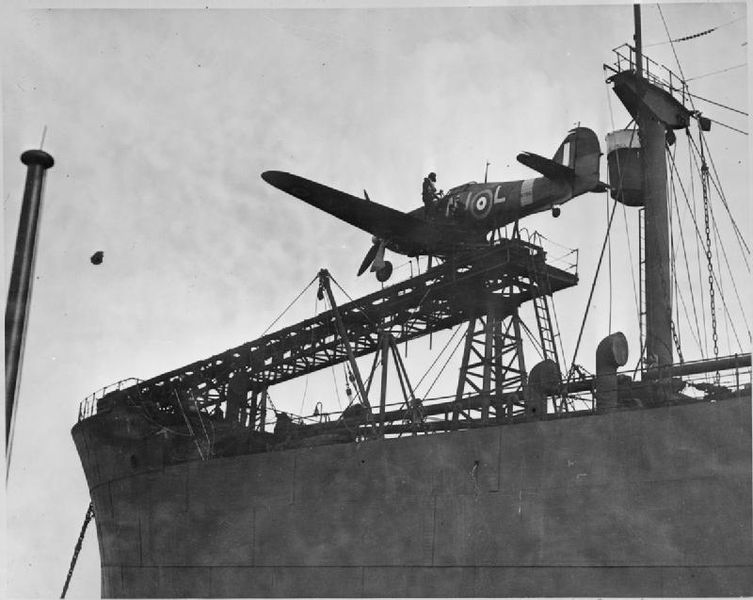 Also called the "CATAFIGHTER" it originated in an order by the end of January, 1941 from the FAA for 50 field-modification kits to be applied to existing surplus RAF Hurricanes (generally older versions, second-hand, battered, worn-out and damaged) to be catapulted at sea. This was the expression of an acute desperation as this was a single-shot endeavour. It was designed as an extreme defence system fitted to key merchant ships (later called CAM-ships) tasked of defending the convoys due to the lack of escort aircraft carriers, in construction. Almost a "suicide weapon", the plane had no way to land after launch and crashed at sea (dangerous), or the unfortunate pilot, its mission done, jumped in parachute, trying to ditch as close as his mothership as possible.
Also called the "CATAFIGHTER" it originated in an order by the end of January, 1941 from the FAA for 50 field-modification kits to be applied to existing surplus RAF Hurricanes (generally older versions, second-hand, battered, worn-out and damaged) to be catapulted at sea. This was the expression of an acute desperation as this was a single-shot endeavour. It was designed as an extreme defence system fitted to key merchant ships (later called CAM-ships) tasked of defending the convoys due to the lack of escort aircraft carriers, in construction. Almost a "suicide weapon", the plane had no way to land after launch and crashed at sea (dangerous), or the unfortunate pilot, its mission done, jumped in parachute, trying to ditch as close as his mothership as possible.
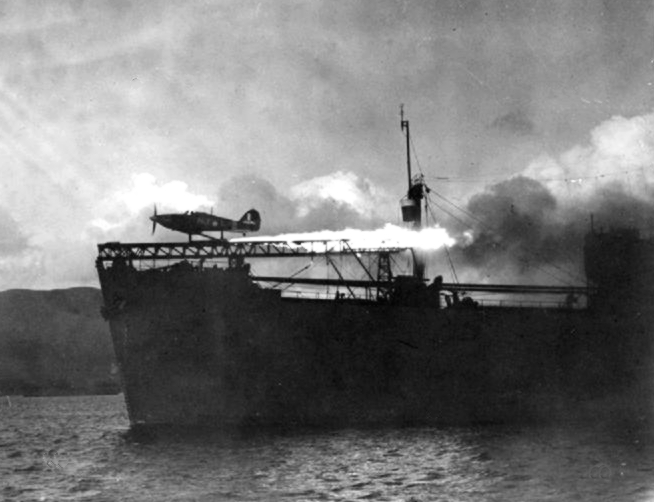
Rocket-assisted catapult launch from an unidentified CAM ship in 1941
Those 35 merchant ships selected were called "Catapult Armed Merchantmen" henece the acronym and will be the object of a separate article in the future. They also had a crane in an attempt to recuperate the ditched Hurricane. The standard navy steam catapult cannot be used and a specially tailored rocker-powered cradle version was installed at the prow, on lattice work and long enough to propel the fighter at the right speed for it to be airborne. Each CAM ship carried between one and three Hurricanes and a crane to bring them on stand. Five Royal Navy Auxiliary vessels were also fitted the same, as "Fighter Catapult Ships" or FC ships. They were tasked to shoot down spying FW-200 condor long-range German bombers.
The first combat launch was on June 18, 1941 (six months after the order) from FCS HMS Maplin, downing as expected the Fw200 Condor over the convoy. This also came as schock to the Luftwaffe HQ which believed to have impunity over the Atlantic. The first "Hurricats" modification, to stay longer aloft, was to instal a 44 gallon overload tank, but it appeared in some case it would also enable the pilot to attmpt to return on land after launch. Given its use, pilots soon obtained a modification of the sliding cockpit hood, making it easier to jettision. There was also an inflatable dinghy fitted, easily accessible. It's not the Hurricat was sinking like a brick, as its largely wooden construction make it float somewhat, but openings all around its underwings and under fuselage, especially air intakes contributed to its gradual flooding, leaving just enough time for the pilot to escape.

The Fighter Control Ship HMS Springbank in 1942, note the amidship rotating catapult for better acces to the three spare Hurricats.
The combat record of CAM ships soon proved the idea was not that far-fetched and ultimately 250 "Hurricat" were ordered and delivered. As escort carriers arrived in service no orders followed but CAM ships of all types served well into 1944, finding new use with the Murmansk (arctic) convoys well into late 1943 and early 1944 until all "Hurricats" were spent.
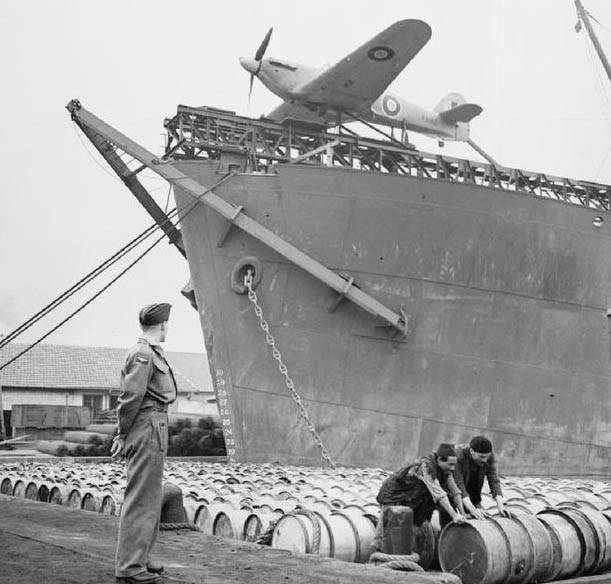

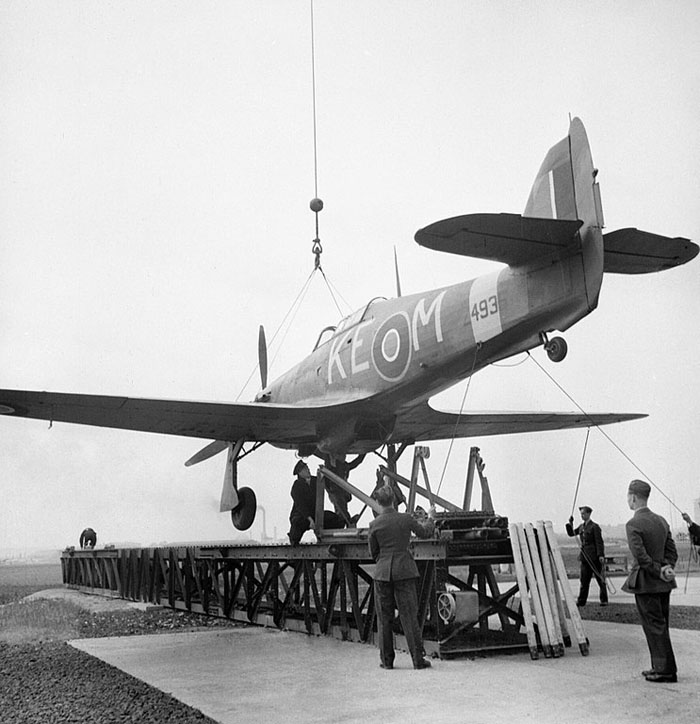
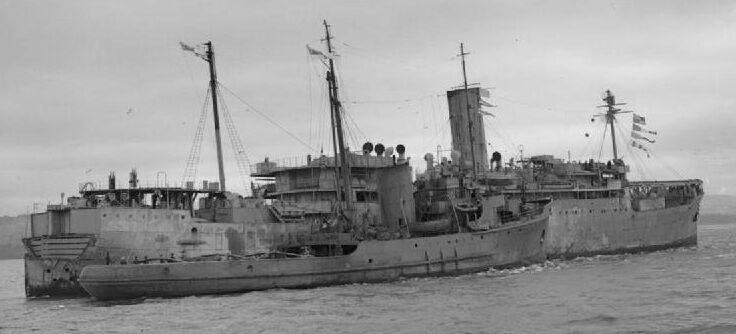
HMS Ariguani
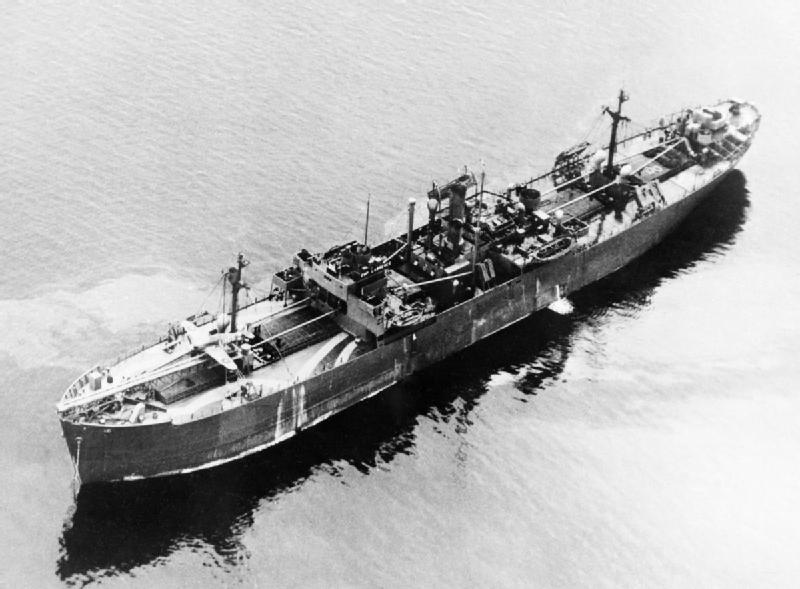
HMS Empire Lawrence in 1941
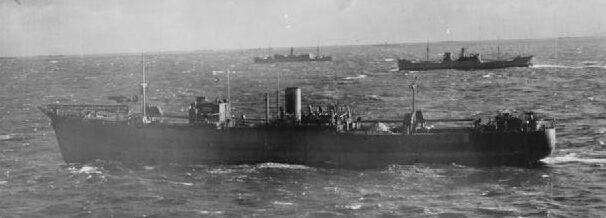
HMS Empire Spray
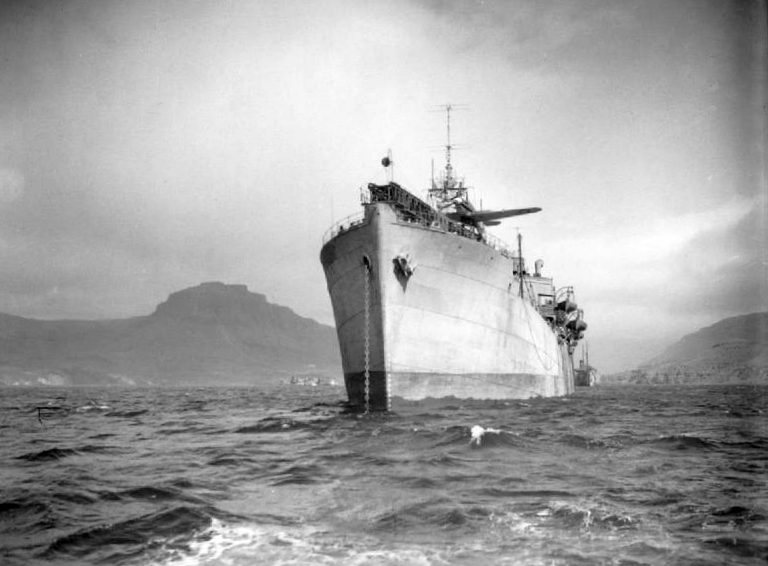
Empire Tide in 1943
Sea Hurricane Mk IB:
The "Hooked Hurricane" introduced carrier a deck arrestor equipment (arresting hook, hence the nickname) while it still retained the catapult spool function. The combination gear enabled the aircraft to operate from both merchant vessels and carrier decks without additional work added. The Mk IB appeared across 340 total conversions.Sea Hurricane Mk IC:
This model followed and contained the equipment of the Mk IB variant but introduced the all-cannon wing of its land-based Hurricane brethren (4 x Hispano cannons, two per wing). Their Rolls-Royce Merlin III series engines of 1,400 horsepower were also altered for improved service at lower altitudes, making this mark a more potent form. Service entry of the type was during February of 1942 and 400 conversions were added.The Sea Hurricane Mk IIC:
The IIc was next in line with its uprated Rolls-Royce XX engine of 1,460 horsepower. These were further evolved over-water warfighters by way of specialized naval radio kits installed. They also retained the all-cannon wing of the Mk IC variant. These Mk IICs went on to serve aboard Royal Navy carriers once carriers became more available in the numbers required.The Sea Hurricane Mk XIIA:
It was a Canadian-built Hurricane Mk XIIA land-based model converted to the Sea Hurricane IIc standard. Canada also contributed over 1,400 land-based versions to the Hurricane 14,000+ total during the war and many were also converted for carrier use.Royal Navy service
HMS Illustrious, Formidable and Victorious soon operated the Sea Hurricane on their deck parks of six machines, unable to fold their wings and thus to be sheltered in the hangar. Insteasd they were left exposed to the weather, water spray of open sea,and soon placed on outrigger struts to not hamper deck operations. Some were simply lashed to the decks of early escort carriers, also as permament pack, and all had to be in the air before landing in turn. This put a strain on maintenance, but the model proved remakably adapted to carrier use. Despite a loss of performances due to add-on navalization weight, its ruggedness made it capable of handing the new rough conditions well. Its serviceability remained surprisingly high, especially compared later to the Seafire, but this had much to do with its undercarriage, with a large span and easier to reinforce.The first FAA squadron receive the Sea Hurricane IB was Sqn. 880, later assigned to HMS Furious, delivered in January 1941 but only seeing sea operations in July. On July 21, one of these scored its first kill, a reconnaissance Do 18 flying boat off Norway. By the end of this year, some 100 Sea Hurricanes IBs in 801, 806 and 885 squadrons based on HMS Argus, Eagle, Formidable and Victorious added many more kills, and the model soon became the best FAA fighter in operation, even outpacing the Fairey Fulmar and Sea Gladiator.
Eventually 32 FAA squadrons received the Sea Hurricane IB. They saw action over the Atlantic, Norwegian coast and Russian Convoys ans well as the Mediterranean and the always dangerous Malta Convoys. Fortunately the short range of the Me 109 made such encounters rare and the Sea Hurricane usual preys were axis bombers.
The Mark Ic latter came with four 20mm cannons, Merlin III engine, and started to appear in squadron in early 1942 with 70 having their engines upgarded to the Merlin XX (Redesignated IIc). The Ic was first deployed with 811 Squadron in January 1942. The heavier guns took a toll in speed which fell to 256 kts at 15,000 ft. Limited numbers saw service on HMS Eagle sunk in Pedestal, and the rest in Furious and Victorious.
It would be Operation Pedestal that would be the shining moment of the type, with the heavy air attacks beaten back repeatedly along the way by scores of Sea Hurricanes making up for the bulk of the patrols. Soon after the Mk IIC gradually appeared and replaced it. The up-engined Sea Hurricane IIC arrived by late 1942 and became the new standard until gradual replacement by the Seafire in 1944, first on fleet carriers and then on escort ones.
Fleet Air Arm Sea Hurricanes would score an impressive kill-to-loss ratio, especially during the Malta convoys, but also operating from escort carriers in the Atlantic, so much so that incursion of FW-200s, Do-217 or Ju-88s over convoys, detected by radar, were paid dearly. On 26 May 1944 along, Sea Hurricanes IIcs from HMS Nairana claimed three Ju 290 reconnaissance aircraft in an hour.
The 1460hp Merlin XX of the IIC brought the Sea Hurricane to 342 mph at 22,000 ft and internal fuel reserves alone procured 460 miles at economical range ported to 908 with the two external 44 Imp gal drop tanks. Some 18 FAA squadrons flew the IIC, last operational Sea Hurricane seeing service notably on the HMS Vindex and Nairana.
Operation Torch in November 1942 saw some 40 Sea Hurricanes launched between HMS Avenger, Biter and Dasher (the first was sunk by U-155, carrying both her air group and pilots to the bottom). The very last Sea deliveries intervened by August 1943, just as it was deiscarded from front-line squadrons. Folding-wing Martlets were seen as a better alternative already from late 1942, and by 1944, the 'difficult' but powerful Corsair made it completely obsolete. Still, some pilots transiting to the Seafire found the Hurricane far more robust. 835 Squadron operated the type last, only transitioning to Martlets in September 1944 (escort carrier HMS Nairana).
"Perhaps it is sufficient to say that, contrary to logic, it (the sea hurricane) took to the naval environment remarkably well. A thoroughly competent Fleet fighter it was not and could never have been, but it was a great dogfighter with, in its cannon-armed versions, plenty of punch and, most important, it reached the Fleet Air Arm at a time when that service desperately needed a relatively fast and reasonably modern single-seat fighter embarked in its carriers."
"Short in range with the ditching propensities of a submarine, harsh stalling characteristics, a very mediocre view for deck landing and an undercarriage that was as likely as not to bounce it over the arrester wires. What less likely a candidate for deployment aboard aircraft carriers as a naval single-seat fighter than the Hurricane could have been imagined … Yet, legacy of parsimony, expediency and shortsightedness inflicted on British naval aviation (it) undoubtedly was, the Hurricane was to take to the nautical environment extraordinarily well."
— Captain Eric Brown, Wings of the Navy
Sources/read more
Books
Hawker Hurricane and Sea Hurricane By Tony O'Toole, Martin Derry and Neil Robinson
Links
On armouredcarriers.com
key.aero/article/little-known-story-behind-hawker-hurricane-prototype
Sydney Camm
fiddlersgreen.net (generic)
Wikimedia commons photos
wiki
militaryfactory.com
Videos
Original Pathé footage
restoring a sea hurricane
The model corner

Airfix Hawker Sea Hurricane Mk.IB N° A05134 1:48 Hawker 'Sea Hurricane' Mk.Ib Royal Navy Ark Models 1:48 Sea Hurricane Mk.IA 'Fleet Air Arms' Hasegawa 1:48 Sea Hurricane Mk Ib Arma Hobby 1:72, etc.
General Query on scalemates
Gallery
Author's illustrations: Types and liveries

Hurricane Mk.I 800 NAS Gosport Training United February 1940

General Aviation limited Sea Hurricane Mark Ia, CAM Empire Tide 1941 ("Hurricat")

Mk Ia 760 NAS Yeovilton August 1941

MkIb 801 NAS Lt. Hutton 801 Sqn. HMS Victorious, Operation Pedestal

Mk.IIb 768 NAS Macrihanish August 1943

Mk.IIb 880 Sqn. HMS Indomitable, Operation Ironclad

Mk.IIc 825 Sqn. FAA HMS Vindex, March 1944

Mk.IIc 835 NAS HMS Nairana, May 1944

Mk.XII 800 NAS Operation Torch November 1942
Additional photos










Surviving Sea Hurricanes





- Lohner E (1913)
- Macchi M3 (1916)
- Macchi M5 (1918)
- Ansaldo ISVA (1918)
- Sopwith Baby (1916)
- Short 184 (1916)
- Fairey Campania (1917)
- Sopwith Cuckoo (1917)
- Felixstowe F.2 (1917)
- Friedrichshafen FF 33 (1916)
- Albatros W4 (1916)
- Albatros W8 (1918)
- Hanriot HD.2
- Grigorovitch M5
- IJN Farman MF.7
- IJN Yokosho Type Mo
- Yokosho Rogou Kougata (1917)
- Yokosuka Igo-Ko (1920)
- Curtiss N9 (1916)
- Aeromarine 39
- Vought VE-7
- Douglas DT (1921)
- Boeing FB.5 (1923)
- Boeing F4B (1928)
- Vought O2U/O3U Corsair (1928)
- Blackburn Blackburn (1922)
- Supermarine Seagull (1922)
- Blackburn Ripon (1926)
- Fairey IIIF (1927)
- Fairey Seal (1930)
- LGL-32 C.1 (1927)
- Caspar U1 (1921)
- Dornier Do J Wal (1922)
- Rohrbach R-III (1924)
- Mitsubishi 1MF (1923)
- Mitsubishi B1M (1923)
- Yokosuka E1Y (1923)
- Nakajima A1N (1927)
- Nakajima E2N (1927)
- Mitsubishi B2M (1927)
- Nakajima A4N (1929)
- CANT 18
WW1
✠ K.u.K. Seefliegerkorps:
 Italian Naval Aviation
Italian Naval Aviation
 RNAS
RNAS
 Marineflieger
Marineflieger
 French Naval Aviation
French Naval Aviation
 Russian Naval Aviation
Russian Naval Aviation
 IJN Air Service
IJN Air Service
 USA
USA
Interwar
 Interwar US
Interwar US
 Interwar Britain
Interwar Britain
 Interwar France
Interwar France
 Interwar Germany
Interwar Germany
 Interwar Japan
Interwar Japan
 Interwar Italy
Interwar Italy
- Curtiss SOC seagull (1934)
- Grumman FF (1931)
- Curtiss F11C Goshawk (1932)
- Grumman F2F (1933)
- Grumman F3F (1935)
- Northrop BT-1 (1935)
- Grumman J2F Duck (1936)
- Consolidated PBY Catalina (1935)
- Brewster/NAF SBN-1 (1936)
- Curtiss SBC Helldiver (1936)
- Vought SB2U Vindicator (1936)
- Brewster F2A Buffalo (1937)
- Douglas TBD Devastator (1937)
- Vought Kingfisher (1938)
- Curtiss SO3C Seamew (1939)
- Douglas SBD Dauntless (1939)
- Grumman F4F Wildcat (1940)
- F4U Corsair (NE) (1940)
- Brewster SB2A Buccaneer (1941)
- Grumman TBF/TBM Avenger (1941)
- Consolidated TBY Sea Wolf (1941)
- Grumman F6F Hellcat (1942)
- Curtiss SB2C Helldiver (1942)
- Curtiss SC Seahawk (1944)
- Grumman F8F Bearcat (1944)
- Ryan FR-1 Fireball (1944)
- Douglas AD-1 Skyraider (1945)
Fleet Air Arm
- Fairey Swordfish (1934)
- Blackburn Shark (1934)
- Supermarine Walrus (1936)
- Fairey Seafox (1936)
- Blackburn Skua (1937)
- Short Sunderland (1937)
- Blackburn Roc (1938)
- Fairey Albacore (1940)
- Fairey Fulmar (1940)
- Grumman Martlet (1941)
- Hawker sea Hurricane (1941)
- Brewster Bermuda (1942)
- Fairey Barracuda (1943)
- Fairey Firefly (1943)
- Grumman Tarpon (1943)
- Grumman Gannet (1943)
- Supermarine seafire (1943)
- Blackburn Firebrand (1944)
- Hawker Sea Fury (1944)
IJN aviation
- Aichi D1A "Susie" (1934)
- Mitsubishi A5M "Claude" (1935)
- Nakajima A4N (1935)
- Yokosuka B4Y "Jean" (1935)
- Mitsubishi G3M "Nell" (1935)
- Nakajima E8N "Dave" (1935)
- Kawanishi E7K "Alf" (1935)
- Nakajima B5N "Kate" (1937)
- Kawanishi H6K "Mavis" (1938)
- Aichi D3A "Val" (1940)
- Mitsubishi A6M "zeke" (1940)
- Nakajima E14Y "Glen" (1941)
- Nakajima B6N "Jill" (1941)
- Mitsubishi F1M "pete" (1941)
- Aichi E13A Reisu "Jake" (1941)
- Kawanishi E15K Shiun "Norm" (1941)
- Nakajima C6N Saiun "Myrt" (1942)
- Yokosuka D4Y "Judy" (1942)
- Kyushu Q1W Tokai "Lorna" (1944)
Luftwaffe
- Arado 196 (1937)
- Me109 T (1938)
- Blohm & Voss 138 Seedrache (1940)
Italian Aviation
- Savoia-Marchetti S.55
- IMAM Ro.43/44
- CANT Z.501 Gabbiano
- CANT Z.506 Airone
- CANT Z.508
- CANT Z.511
French Aeronavale
- GL.300 (1926-39)
- Levasseur PL.5 (1927)
- Potez 452 (1935)
- Loire 210 (1936)
- Loire 130 (1937)
- LN 401 (1938)
Soviet Naval Aviation
- Shavrov SH-2 (1928)
- Tupolev TB-1P (1931)
- Beriev MBR-2 (1930)
- Tupolev MR-6 (1933)
- Tupolev MTB-1 (1934)
- Beriev Be-2 (1936)
- Polikarpov I16 naval (1936)
- Tupolev MTB-2 (1937)
- Ilyushine DB-3T/TP (1937)
- Beriev Be-4 (1940)
-
Skoda Š-328V
R-XIII Idro
Fokker C.XI W (1934)
WW2
- De Havilland Sea Vixen
- Hawker Sea Hawk
- Supermarine Scimitar
- Blackburn Buccaneer
- Hawker Sea Harrier
- Douglas A4 Skyhawk
- Grumman F9F Panther
- Vought F8 Crusader
- McDonnell-Douglas F-4 Phantom-II
- North Am. A5 Vigilante
- TU-142
- Yak 38 forger
☢ Cold War
✧ NATO
 Fleet Air Arm
Fleet Air Arm
 US Navy
US Navy
☭ Warsaw Pact
Merch

Seafire Mark 45; HMS Pretoria Castle

Zeros vs its aversaries

Aichi D3A “Val” Junyo

Mitsubishi A5M poster

F4F wildcat

Macchi M5

SBD Dauntless Coral Sea

SBD Dauntless USS Enterprise

SBD-4 CV22